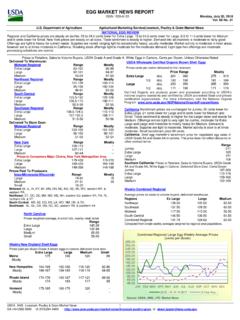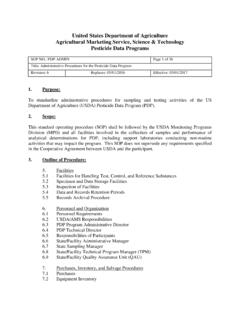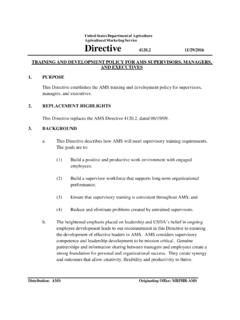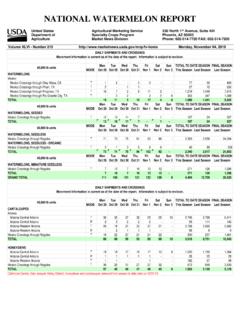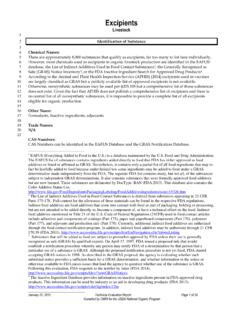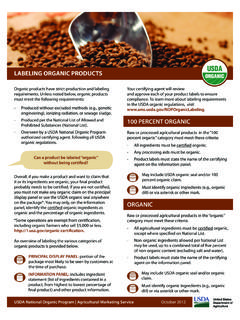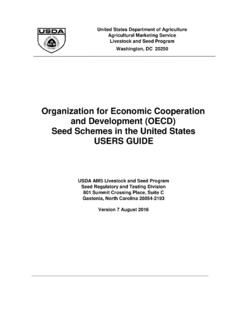Transcription of Barge Transportati on - Agricultural Marketing Service
1 Chapter 12 Barge Transportati on369 Chapter 12: Barge Transportation Before there were locks and dams on the Nation s rivers, the early commercial vessels were designed to travel in shallow waters and had flexible cargo capability to handle passengers, freight, or livestock. Some were equipped with second decks for additional carrying capacity. These boats, called packets, made regular trips between river cities and were a primary mode of transportation in the central United States for the first half of the 1800s. Packets were propelled by steam-driven paddle wheels that permitted shallow-draft navigation on the constantly changing and unpredictable rivers. Early steamboat traffic was most prevalent during the spring, when high water permitted travel along most of the river system.
2 The topography of the valley on the lower Mississippi River, combined with water flows from the Upper Mississippi, Missouri and Ohio Rivers, produced conditions for year-round navigation. The steamboat era ended as railroads began to cross the United States. Railroads offered lower rates and provided more city-to-city routes, especially to western destinations. In an effort to become more competitive, packets added barges to the sides of the vessels to increase cargo capacity. Before the addition of side barges, most packets were side-wheeled paddle boats. To accommodate the side barges, the paddle wheel was moved to the stern of the boat. Eventually, the packet evolved into today s diesel-powered tow boat with propellers that pushes barges up and down the However, it became evident that improvements to the river system were necessary to allow safe and dependable movements on the river.
3 Figure 12-1: Ohio packet boats in the early 19th Century Source: 2006 History of Akron & Summit County 370 As early as the 1830s, the Federal Government began making navigation improvements to the rivers. In the early years, improvements were limited to the removal of river hazards, such as submerged rocks, shoals, and sandbars. In 1878, Congress authorized a 4 -foot deep channel with canals and locks that allowed boats to bypass rapids and other obstructions. In 1907, Congress authorized an increase in the channel depth to 6 feet. This increase was accomplished by the construction of hundreds of wing dams that extend from the shore to force the flow of the river towards the main navigation channel during low water.
4 Finally, in 1930, Congress authorized the Army Corps of Engineers (Corps) to construct and maintain a navigation channel 9 feet deep with a minimum width of 400 feet. Passage of this authorization marked the beginning of a massive dam-building program that built the 29 locks on the Upper Mississippi River and 8 locks on the Illinois River. The lock farthest downriver on the Mississippi is near St. Louis. There are no locks between St. Louis and New Orleans. There are also four locks on the Columbia River and four locks on the Snake River. The original purpose of the Federal involvement in inland navigation was to assist in the development of the frontier. Today, the Federal government s role stems from an interest in helping to facilitate commercial navigation by providing safe, reliable, highly cost-effective, and environmentally sustainable waterborne transportation The Federal agencies most directly involved in the development and operation of the Nation s navigation system are the Army Corps of Engineers, the Department of Transportation (DOT), the Department of Homeland Security (DHS), and the Department of Commerce (DOC).
5 The DHS, through the Coast Guard, has responsibility for vessel and navigation safety and provides navigation aids and search and rescue services . DOT s Maritime Administration supports the development of ports, intermodal systems, and domestic shipping, and DOT s St. Lawrence Seaway Development Corporation supports the operation of that waterway in partnership with Canadian authorities. DOC s National Oceanic and Atmospheric Administration provides surveys, tidal information, and coastal charts. 371 Barge Traffic In 2007, 622 million tons245 of goods moved on the inland waterways, which include all movements within the boundaries of the contiguous 48 states and Alaska.
6 The primary commodity moved on the waterways is coal, accounting for 29 percent of all tonnages (Figure 12-2). Petroleum is the next largest commodity group with 27 percent; crude materials (forest products, sand, gravel, ores, scrap, and salt) are next largest with 18 percent; and food and farm products are fourth, with 12 percent. Figure 12-2: Barge tonnage by commodity group, 2007 Source: Waterborne Commerce Statistics, Army Corps of Engineers The Importance of the Inland Waterways to Agriculture The Army Corps of Engineers operates and maintains about 12,000 miles of rivers, canals, and other inland and intracoastal waterways (inland waterways) in the United States.
7 The Mississippi River and the Illinois Waterway are the primary waterways for moving Agricultural products by Barge . They are especially important for transporting bulk grains and oilseeds from the Midwest to export ports in the New Orleans region. Other important rivers include the Columbia River in the Pacific Northwest, which also moves some bulk grains, oilseeds, and fertilizer/chemicals; and coastal waterways that supply poultry and hog operations in the mid-Atlantic region (Figure 12-2). 372 Across the inland waterways, there are 191 active lock sites with 237 lock chambers. Some locks are equipped with more than one chamber, adding more capacity to that site.
8 In 2006-2008 the Ohio River carried 18 percent of southbound grain Barge movements through the locking portion of the river system, the Upper Mississippi River 76 percent and the Arkansas River the remaining 6 percent. Barges have a 9 percent share of Agricultural tonnages and a 12 percent share of Agricultural ton-miles most of which is accounted for by movements of grain, animal feed, and fertilizers on the Mississippi River and its tributaries. A complete discussion of the importance of the inland waterways to agriculture can be found in Chapter 2: The Importance of Freight Transportation to Agriculture. Figure 12-3: Agriculturally-significant waterways Source: AMS 373 Figure 12-4: Barge Tow on the Mississippi River Source: USDA Today s Barge Industry Today s Barge industry is driven by the fundamental forces of supply and demand, influenced by a variety of factors, including local weather patterns, navigation circumstances, domestic and international consumption of Agricultural and industrial products, crop production, trade policies and the price of The demand for dry-cargo freight on the inland waterways is driven by the production volumes of dry bulk commodities that require competitive Barge transportation.
9 Historically, the major commodity groups for dry-cargo Barge freight have been: Coal for domestic utility companies, industrial and coke producers, and export markets. Construction commodities, such as cement, limestone, sand, and gravel. Grain and oilseeeds, such as corn and soybeans, for export markets. Other commodities include products used in the manufacturing of steel, finished and partially finished steel products, ores, salt, gypsum, fertilizer, and forest products. The demand for liquid freight is driven by the demand for bulk chemicals used in domestic production, including styrene, methanol, ethylene glycol, caustic soda, and other products. It is also affected by the demand for refined petroleum products and Agricultural -related products such as ethanol, vegetable oil, bio-diesel, and molasses.
10 374 Freight rates in both the dry and liquid freight markets are a function of the relationship between the demand for these commodities and the supply of barges available at any given point in time. Grain and Tank Barge Fleet According to the Corps publication Waterborne Transportation Lines of the United States,247 there were 32,211 non-self propelled vessels (barges of all categories) on the inland waterways in 2006. Of this number, 13,062 were covered barges, which haul most of the grain. About 36 percent of the covered barges were greater than 25 years old. The average economic useful life of a dry cargo Barge is generally estimated to be between 25 and 30 years.

